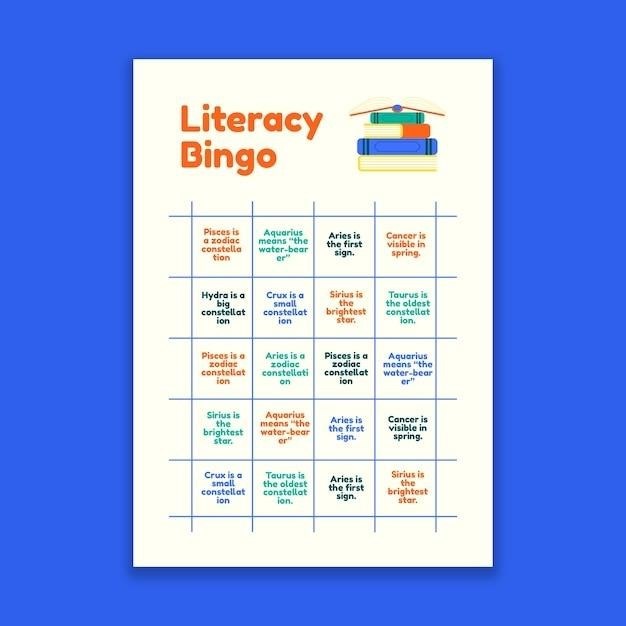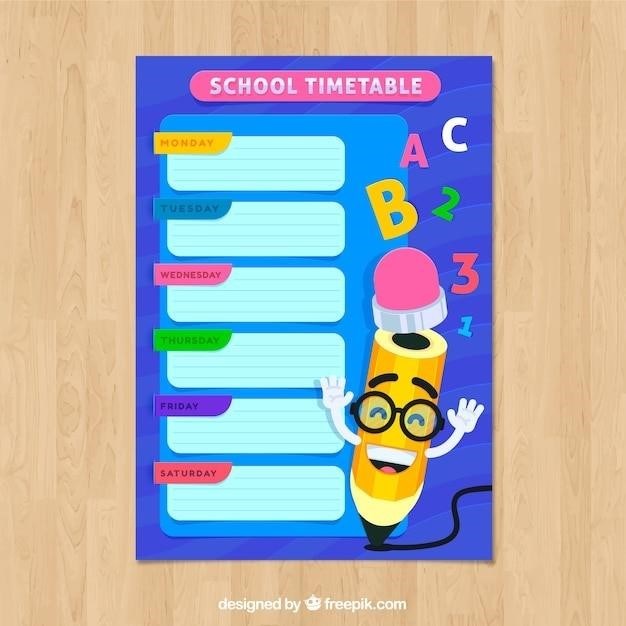Year 3 and 4 Spelling List PDF⁚ A Comprehensive Guide
This comprehensive guide explores the Year 3 and 4 spelling list PDF, a valuable resource for educators and parents alike. We’ll delve into the National Curriculum’s requirements, statutory spelling words, common exception words, and practical teaching strategies. This guide will equip you with the knowledge and tools to effectively teach and learn spelling in Years 3 and 4.
Introduction
In the realm of primary education, spelling is a fundamental skill that underpins effective communication and literacy development. Mastering spelling empowers children to express themselves confidently in writing, enhancing their ability to convey thoughts and ideas clearly. For students in Years 3 and 4, the journey of spelling mastery takes a significant step forward, with the introduction of a comprehensive statutory word list that forms the cornerstone of their spelling curriculum. This word list, often presented in a convenient PDF format, serves as a roadmap for educators, providing a clear framework for teaching and assessing spelling proficiency. This guide delves into the intricacies of the Year 3 and 4 spelling list PDF, exploring its significance, content, and practical applications in the classroom.
The Year 3 and 4 spelling list PDF is an invaluable resource for teachers, parents, and students alike. It provides a structured approach to teaching spelling, ensuring that children are equipped with the essential vocabulary and spelling rules necessary for effective written communication. By adhering to the guidelines outlined in the PDF, educators can foster a consistent and comprehensive learning experience for their students, empowering them to become confident spellers. This guide aims to illuminate the importance of the Year 3 and 4 spelling list PDF, providing insights into its structure, content, and practical applications in the classroom.
The National Curriculum and Spelling Lists
The National Curriculum in England plays a pivotal role in shaping the educational landscape for primary school children. It outlines the essential knowledge, skills, and understanding that students are expected to acquire by the end of each Key Stage. Within this framework, spelling occupies a prominent position, recognizing its crucial role in literacy development. The National Curriculum provides specific guidance on spelling for each year group, including a statutory word list for Years 3 and 4. This word list encompasses a collection of words that children are expected to be able to spell by the end of Year 4, serving as a benchmark for spelling proficiency at this stage.
The statutory word list for Years 3 and 4 is not merely a random assortment of words. It is carefully curated to reflect the common spelling patterns, rules, and exceptions that children encounter in their reading and writing. This deliberate selection ensures that the word list provides a comprehensive foundation for spelling development, addressing a wide range of linguistic complexities. The National Curriculum also emphasizes the importance of teaching spelling rules and patterns alongside the statutory word list, ensuring that children develop a deep understanding of the English language’s spelling system. This approach equips students with the tools they need to decode and encode words effectively, fostering confidence and fluency in their written communication.
Year 3 and 4 Statutory Spelling Words
The Year 3 and 4 statutory spelling words represent a carefully selected set of words that children are expected to master by the end of Year 4. These words encompass a range of spelling patterns, rules, and exceptions, providing a comprehensive foundation for spelling development. The list includes words that are commonly used in children’s writing and those that are often misspelled. The National Curriculum in England emphasizes the importance of teaching these statutory words, as they form a core element of spelling proficiency at this stage.
Examples of statutory spelling words for Years 3 and 4 include⁚ accident, actually, address, answer, appear, arrive, believe, bicycle, breath, breathe, build, busy, business, calendar, caught, centre, circle, complete, consider, continue, decide, describe, different, difficult, disappear, early, earth, eight, eighth, enough, exercise, experiment, famous, February, forward, friend, group, guard, heard, heart, history, interest, knowledge, learn, minute, money, month, natural, naughty, notice, often, occasionally, opposite, ordinary, people, picture, possible, promise, question, recent, remember, sentence, separate, special, straight, strange, suggest, sure, thought, through, today, tomorrow, useful, weight, woman, women, world, write, and wrong. This list serves as a valuable resource for educators and parents, providing a clear framework for teaching and learning spelling in Years 3 and 4.
Spelling Rules and Patterns Taught in Years 3 and 4
The spelling rules and patterns taught in Years 3 and 4 are crucial for developing confident spellers. These rules and patterns provide a structured approach to understanding how words are formed and spelled. By mastering these concepts, children gain a deeper understanding of the English language and become more independent spellers. Here are some key spelling rules and patterns introduced in these years⁚
Adding Suffixes⁚ Children learn to add suffixes like -er, -ing, -ed, and -ly to verbs and adjectives, understanding how these suffixes change the word’s meaning and spelling. For example, adding -ing to “begin” forms “beginning,” and adding -ed to “walk” forms “walked.”
Words Containing Y⁚ Children learn to spell words where “y” sounds like “i,” such as “myth,” “gym,” and “cry.” They also learn about the spelling changes that occur when adding suffixes to words ending in “y,” like “happy” becoming “happier.”
Words Containing Ou⁚ Children are introduced to the spelling of words where “ou” sounds like “u,” such as “young,” “touch,” and “enough.” This helps them understand the various pronunciations of “ou” in different words.
Homophones⁚ Children learn about homophones, words that sound the same but have different meanings and spellings, such as “to,” “too,” and “two.” This helps them understand the importance of context in determining the correct spelling.
Prefixes⁚ Children are introduced to prefixes, such as “un-“, “re-“, and “dis-“, and learn how they change the meaning of words. For example, adding “un-” to “happy” forms “unhappy,” while adding “re-” to “read” forms “reread.”
By understanding these rules and patterns, children gain a solid foundation for spelling and develop a more confident approach to writing.
Common Exception Words for Year 3 and Year 4
In addition to the spelling rules and patterns, there are a number of common exception words that children in Years 3 and 4 need to learn. These words don’t follow the usual spelling rules and must be memorized; These words are often encountered in everyday reading and writing, making it essential for children to be able to spell them correctly.
Here are some examples of common exception words for Years 3 and 4, often listed in the spelling list PDF⁚
- accident
- actually
- breath
- busy
- calendar
- centre
- guard
- grammar
- naughty
- natural
- recent
- remember
- therefore
- thought
- woman
- weight
- notice
- popular
- promise
- ordinary
- occasionally
Teaching these exception words requires a variety of strategies, such as using flashcards, word games, and repeated practice. It’s important to make the process engaging and fun to help children remember these words effectively.
Resources for Teaching Year 3 and 4 Spelling
There are a wealth of resources available to help teachers and parents effectively teach Year 3 and 4 spelling, making the process engaging and successful. These resources range from printable worksheets and interactive games to online platforms and educational apps; Here are some examples of helpful resources that can be found online or in educational stores⁚

- Spelling Word Lists⁚ These lists, often available in PDF format, provide a comprehensive overview of statutory spelling words, exception words, and words that align with the National Curriculum. They can be used as a reference point for teachers and parents.
- Spelling Worksheets⁚ Printable worksheets offer various activities such as word searches, crosswords, and gap-fill exercises to reinforce spelling skills. These worksheets can be tailored to specific spelling rules, patterns, or exception words.
- Spelling Games⁚ Interactive spelling games provide a fun and engaging way to learn spelling. These games can be found online, on educational apps, or even created using simple materials like flashcards and dice.
- Online Spelling Platforms⁚ Several websites offer online spelling programs that provide interactive lessons, quizzes, and progress tracking. These platforms can be customized to meet individual student needs and provide valuable feedback.
- Educational Apps⁚ Many apps are designed specifically for teaching spelling, offering engaging activities, games, and personalized learning paths. These apps can be accessed on smartphones, tablets, or computers, making learning accessible anytime, anywhere.
By utilizing these resources, teachers and parents can create a comprehensive and engaging learning environment that helps children master spelling skills in Years 3 and 4.
Year 3 and 4 Spelling List PDF⁚ Benefits and Uses
The Year 3 and 4 spelling list PDF offers a multitude of benefits and uses for both educators and learners. It serves as a valuable tool for teaching, learning, and assessing spelling skills. Here are some key advantages of using this resource⁚
- Clear and Comprehensive Reference⁚ The PDF format provides a readily accessible and organized list of statutory spelling words, common exception words, and spelling patterns. This allows teachers and parents to quickly reference the required words for the year level.
- Targeted Instruction⁚ The list enables teachers to tailor their instruction to specific spelling rules, patterns, and exceptions. By focusing on the words outlined in the PDF, teachers can ensure students are learning the most relevant and essential spellings.
- Effective Assessment⁚ The list provides a framework for assessing students’ spelling abilities. Teachers can use the list to create quizzes, tests, and activities to gauge students’ understanding and progress in spelling.
- Home-School Connection⁚ The PDF can be shared with parents to facilitate a consistent approach to spelling instruction at home and at school. This ensures that parents are aware of the specific words and patterns their children are learning and can support their learning at home.
- Printable Format⁚ The PDF format allows for easy printing, making the list readily available for classroom use, homework assignments, or individual study sessions. This flexibility ensures that the list is accessible to students in various learning environments.
The Year 3 and 4 spelling list PDF is a versatile resource that can be adapted to suit various teaching and learning needs. It provides a clear and structured framework for effective spelling instruction and assessment, contributing to improved literacy skills in students.
The Year 3 and 4 spelling list PDF is an indispensable tool for educators and parents seeking to support effective spelling instruction and development. It provides a comprehensive framework for teaching and learning the essential words and spelling patterns required for students in these year levels. By utilizing this resource, teachers can ensure that their students are equipped with the necessary spelling skills to confidently write and communicate effectively.
The list serves as a valuable guide for targeted instruction, assessment, and home-school collaboration. The PDF format allows for easy access, printing, and adaptation to suit diverse learning needs. By embracing the benefits of this resource, educators and parents can work together to empower students to become proficient spellers and confident writers.
The Year 3 and 4 spelling list PDF is not merely a list of words, but a foundation for building strong spelling skills. It is a testament to the importance of providing students with the tools and support they need to succeed in their literacy journey. By utilizing this resource effectively, educators and parents can foster a love of language and empower students to become confident communicators.
